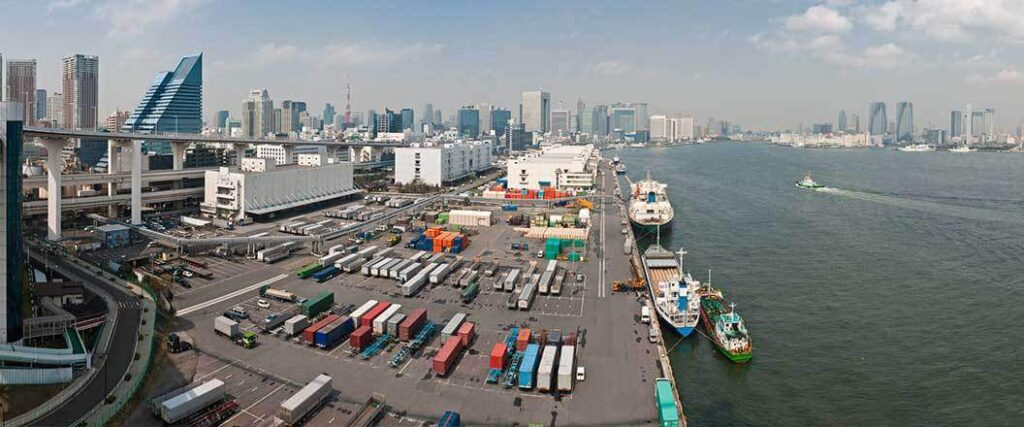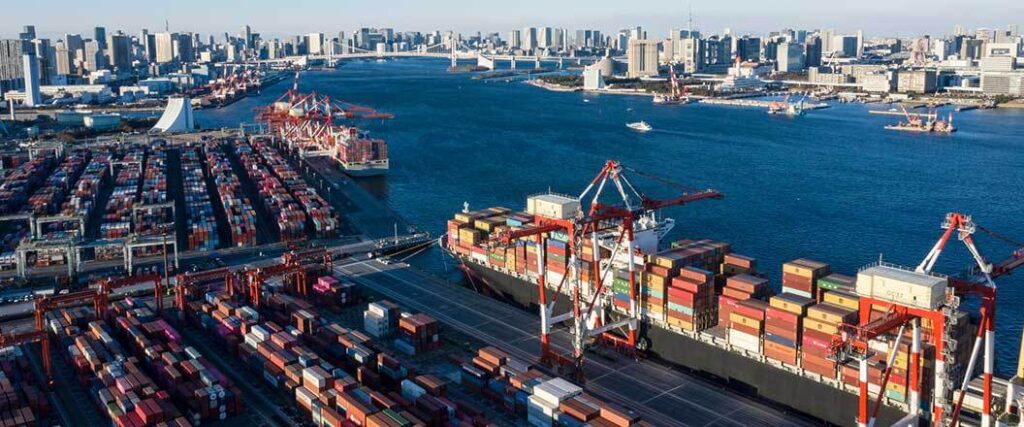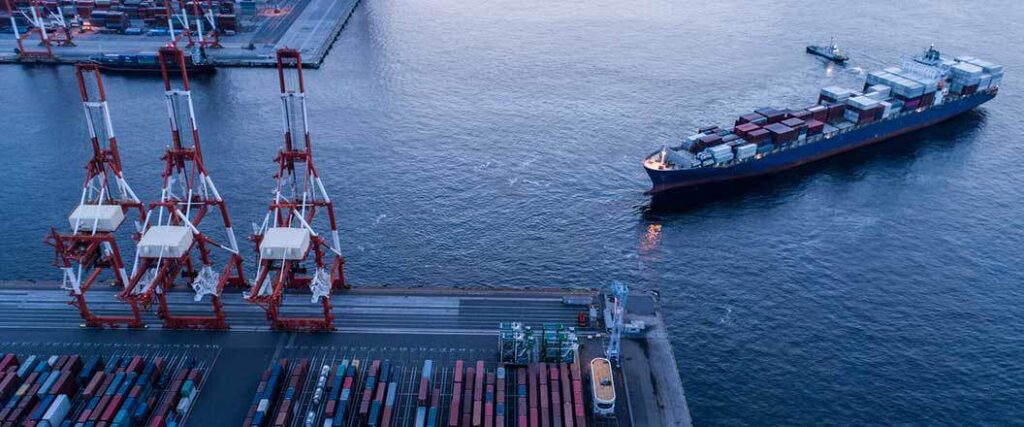Exporting to Japan from the U.S. is becoming increasingly commonplace. As one of the U.S.’s top five trading partners, Japan imports around $74.4 billion worth of goods every year. Despite being a common trading partner, there are quite a few requirements that you will be responsible for as an exporter.
Under the U.S.-Japan Trade Agreement (USJTA), shippers can apply for preferential treatment when exporting to Japan. You’ll need to identify the Schedule B Number for your goods and prepare the right documents in order. Lastly, you’ll need to follow Japanese import compliance regulations.
Exporting from Japan can be challenging, but we’ll provide you with the details to complete this endeavor.

Trade relations between the U.S. and Japan are in excellent condition. Both countries actively trade goods with one another year-round. Japan is the U.S.’s fourth largest trading partner and contributes a good portion to the U.S.’s export market. To better display the great trade relations between these two countries, consider the information in the table below.
| U.S. Goods Exported To Japan | $64.1 Billion |
| Japanese Goods Imported From Japan To the U.S. | $119.5 Billion |
| U.S. Export Services To Japan | $38 Billion |
| Japanese Service Imports To the U.S. | $30.6 Billion |
| U.S. Trade Surplus With Japan | $7.4 Billion |
Provided by the Office Of the United States Trade Representative
There are very few trade barriers between the U.S. and Japan. Back in 2020, both nations entered into the U.S.-Japan Trade Agreement or USJTA. Under this trade agreement, both countries have agreed to do some of the following:
This trade agreement gives better market access to the U.S. and Japan. To help strengthen this already far-reaching trade agreement, the U.S. and Japan entered into the U.S.-Japan Partnership On Trade in 2021.
Another country in Asia you can export to is South Korea. Our article on exporting to South Korea will be able to help you with this task.

The U.S. and Japan might be good trading partners, but certain U.S. goods are more consumed by Japan than others. If you’ve never exported to Japan before, then it’s good to understand which goods are the most popular.
One vital resource that Japan imports from the U.S. is petroleum gas. The reason Japan imports so much petroleum is fairly simple: the country has a limited amount of natural gas of its own. This leaves Japan having to rely on petroleum suppliers like the U.S. to power some of its energy needs.
Another reason why Japan has become dependent upon oil imports is due to the nuclear disaster that took place at Fukushima in 2011. In the aftermath of this disaster, the country halted the operation of its nuclear power plants. Currently, only nine reactors are operating in the country.
Japan uses its petroleum imports to power some of the following industries sectors:
Over the past few years, Japan has gradually reduced its oil imports. That said, the country still imports this product heavily as the table below shows.
| 2017 | 187.64 |
| 2018 | 177.48 |
| 2019 | 175.49 |
| 2020 | 143.04 |
| 2021 | 144.66 |
Medical instruments are another extremely popular commodity that the U.S. export to Japan. Although Japan is revered worldwide for its cutting-edge technology, the country spends a large amount on the medical instruments it imports.
There are two main reasons Japan imports medical instruments into the country and spends so much on healthcare as a whole:
For these reasons, the Japanese market is a great place to get into if you want to export quality medical instruments to the country.
| Orthopedic Instrument | 15% |
| Cannulae/Catheters | 14.7% |
| Artificial Internal Organs | 12.8% |
| Sight Corrective Ophthalmic Lenses | 11.4% |
| Physical Therapy Instruments and Equipment | 5.9% |
| Other | 40.2 |
Japan imports an extremely large amount of agricultural products. Japan is a fairly small island nation and what land is available for farming is not enough for Japan to feed the entirety of its population. Therefore, Japan imports many agricultural products from other nations.
Fortunately for U.S. farmers, the U.S. is one of the top suppliers of agricultural products to Japan. Some of the most popularly exported agricultural goods from the U.S. to Japan are:
The reliance that Japan has on the U.S. for agricultural products isn’t likely to change anytime soon. The import value of Japan’s agricultural imports are reflected below.
| 2017 | 6.43 |
| 2018 | 6.62 |
| 2019 | 6.52 |
| 2020 | 6.21 |
| 2021 | 7.04 |
Machinery is another commodity that the U.S. frequently exports to Japan. The reason for Japan’s consumption of machinery is the same as the country’s reason for importing so much petroleum. Japan simply doesn’t have the natural resources necessary to make the machinery it needs.
The machinery that Japan imports the most includes:
In 2021 there was a significant spike in Japanese imports of electrical machinery that was higher than in the previous four years. The table reflects this data below.
| 2017 | 12.05 |
| 2018 | 12.34 |
| 2019 | 11.99 |
| 2020 | 11.35 |
| 2021 | 13.64 |
While these are the most common goods and services sent to Japan, they’re not the only ones you can export. Some of the other Japanese sectors that import U.S.-made products frequently are:
Regardless of what kind of products your business sells, chances are there is some type of demand for it by Japanese Customers.

There might be a lot of demand for U.S. products in Japan, but finding an importer can be difficult. This can be even more of a problem if you’ve never conducted business in Japan. To provide assistance to exporters and promote trade between the U.S. and Japan, the U.S. Commercial Service is a readily available resource.
In Japan, the U.S. Commercial Service has a few offices scattered throughout the country. They can provide you with information and contacts that will lead you to find a potential trading partner that you can trade with.

Before you can start exporting products to Japan, there are a few preparations that you’re going to need to make before you can export your goods. First, you’re going to need to disclose the Schedule B code that corresponds with the product that you want to export to Japan.
Schedule B numbers are 10-digit codes that U.S. exporters must use when they export domestic goods to another country. These codes are similar to HTS codes, except that they’re applied to exported goods rather than imported ones. The purpose of a Schedule B code is to:
In addition to providing the correct Schedule B number for your exported goods, you’ll need to include the correct Japanese HS code as well. Considering there are over 9,000 Schedule B numbers, as well as a large amount of Japanese HS codes, finding them on your own will be difficult.
Secondly, an export license might also be required for the goods you’re exporting to Japan. According to the International Trade Organization, about 95 percent of all goods exported from the U.S. to another country do not need require an export license. Some of the goods that will require a U.S. export license includes the following:
If you export these goods to Japan, you will also need to obtain a Japanese import license to send these goods to the country. Applying the correct Schedule B numbers, HS codes and obtaining the correct licenses can be hard to do on your own. To rectify this problem, get the help of customs broker.

All exports are going to require some type of documentation. We’ve already discussed a U.S. export and Japanese import license, but there are a variety of other documents that you’ll need. The documents that you’ll need to export goods to Japan include the following:
The first of which is an Import Declaration (Customs Form C-5020). This document contains detailed information about products and services exported to Japan. Next, you will need to include a certificate of origin for your exported goods. A certificate of origin simply indicates that your goods are the U.S.-made. Both documents will be needed if you want to apply for special treatment under a trade agreement.
After you have these documents taken care of, you’ll need to focus on filling out your BOL. There are three purposes of this document:
On the BOL, you will need to include some of the following information:
The BOL is an important document that you will need to include with your exported goods. Other documents like the packing list, commercial invoice and proforma invoice contain roughly the same information as the BOL.
Insurance documentation is the last responsibility that you will have to worry about. Providing a certificate of insurance is a good indicator to Japanese companies or business partners that they will be covered should something unfortunate happen to the shipment.
Filling out these documents can be a confusing and time-consuming task. Shorten the process by hiring a Licensed Customs Broker that can help you through the process.
Our article on documents required for export will give you general information about different types of customs paperwork.

Japan has a few export compliance regulations that many exporters tend to get wrong when they ship to the country. Therefore, you should be able to handle the following steps very carefully to avoid making any mistakes.
The U.S. takes the exportation of goods leaving the country so seriously because of the effect exporting can have on national security interests and foreign policy. To do so, you’ll need to make sure that your goods are classified by the government agencies that regulate exports.
The government agencies that regulate exports leaving the country are:
Depending on which agency regulates your goods, you’ll have to follow their classification requirements. There are also other agencies whose regulations you’ll have to follow for other goods such as the Food and Drug Administration (FDA), but the three above are the main ones you’ll need to worry about.
You can’t always be sure that the company you’re conducting business with is the most reliable. To help protect you, the United States and foreign governments work together to create what is called restricted party lists.
Essentially, these lists are filled with individuals and companies that are prohibited from receiving certain or all types of goods. Some reasons for companies and individuals to be placed on a restricted party list can include the following:
Three primary restricted party lists are maintained by three separate government agencies:
As is the case for every country, individuals and companies operating in Japan that have made it onto these lists. In addition to the lists provided by these government agencies, Japan has its list of restricted parties.
The list is created by Japan’s Ministry of Economy, Trade and Industry (METI) and has numerous restricted parties that exporters are not permitted to send their goods to. Even if the individuals or companies listed by METI are not restricted by any U.S. agency, it’s still a good idea not to conduct business with those individuals.
Sifting through all of these lists on your own is difficult and will eat up precious time. To speed up the process, an export consultant can help discern which individuals or companies are on these restricted parties lists.

When you export goods to Japan, it’s important to have a solid understanding of what tariffs you’ll be facing. As we explained earlier, the USJTA grants preferential treatment for certain U.S. agricultural exports. That said, some goods aren’t covered by this trade agreement.
Fortunately, Japan’s average applied tariff rate is amongst the lowest in the world. Therefore, if your exports don’t qualify for preferential treatment under USJTA, the tariff you do pay won’t be excessive.
Japan is a member of the World Trade Organization (WTO) and like all members of the WTO, it applies what’s called a Most Favored Nation (MFN) tariff on imported goods from other members WTO member countries. The average Japanese MFN tariff rate according to the WTO, via the International Trade Administration (ITA), is the following:
Imports for goods from the following industries are:
Now that you know what the MFN tariff rate is, you need to know about the tariff rates Japan applies to its goods and which one to go by. Japan uses the same HS system that the U.S. does. In the Japanese tariff schedule, you’ll notice that there are five rate different columns. Each column is labeled:
Any export you have that does not receive preferential treatment under the USJTA will have the “WTO Rate” applied to them instead. Since both Japan and the U.S. are part of the WTO, the WTO rate will be the same as the MFN rate we listed for the goods above.
If, however, your exports are agricultural goods that are eligible for preferential treatment, you’ll go with the rate displayed under the “Temporary Rate” column. That said, you will still need to apply for preferential treatment if you want this rate to be applied to your goods.
Whether you’re exporting goods to Japan or somewhere else in the world, you’re going to have to complete a variety of different responsibilities. Therefore, you should consider getting help from professionals.
With the help of one of our export consultants, we guarantee that we’ll be able to help you along the exporting process with ease. Tell us what goods you’re exporting and where the final destination is, and from there, we can provide you with all the guidelines and regulations you’ll need to comply with.
Consulting sessions with our specialists are also another option you can take advantage of. During these sessions, you can ask all the questions you want and our consultants will work to find you the answer.
Cargo Export USA offers a variety of services dedicated to making your export venture a success. Choose a partner with experience handling export procedures for all kinds of products.
If you’re not ready for a session and want to know your next step in the exporting process, give our team a call at 866-301-0635.